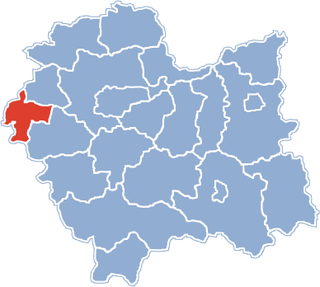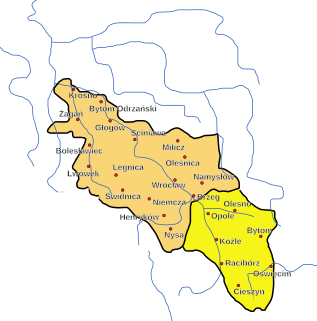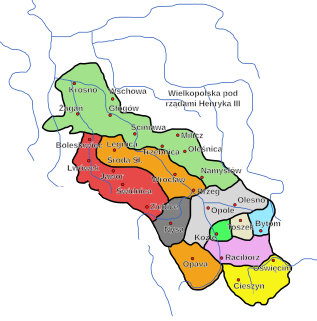
Dankowice is a village in the administrative district of Gmina Wilamowice, within Bielsko County, Silesian Voivodeship, in southern Poland. It lies approximately 4 kilometres (2 mi) north-west of Wilamowice, 12 km (7 mi) north of Bielsko-Biała, and 37 km (23 mi) south of the regional capital Katowice.

Osiek is a village in Oświęcim County, Lesser Poland Voivodeship, in southern Poland. It is the seat of the gmina called Gmina Osiek. It lies approximately 12 kilometres (7 mi) south of Oświęcim and 50 km (31 mi) west of the regional capital Kraków.

Stara Wieś is a village in the administrative district of Gmina Wilamowice, within Bielsko County, Silesian Voivodeship, in southern Poland. It lies approximately 6 kilometres (4 mi) west of Wilamowice, 8 km (5 mi) north of Bielsko-Biała, and 40 km (25 mi) south of the regional capital Katowice. The village has a population of 1,978.

Przecieszyn is a village in the administrative district of Gmina Brzeszcze, within Oświęcim County, Lesser Poland Voivodeship, in southern Poland. It lies approximately 5 kilometres (3 mi) south-east of Brzeszcze, 10 km (6 mi) south of Oświęcim, and 56 km (35 mi) west of the regional capital Kraków.

Bulowice is a village in the administrative district of Gmina Kęty, within Oświęcim County, Lesser Poland Voivodeship, in southern Poland. It lies approximately 8 kilometres (5 mi) south of Kęty, 25 km (16 mi) south of Oświęcim, and 56 km (35 mi) south-west of the regional capital Kraków.

Łęki is a village in the administrative district of Gmina Kęty, within Oświęcim County, Lesser Poland Voivodeship, in southern Poland. It lies approximately 6 kilometres (4 mi) north of Kęty, 12 km (7 mi) south of Oświęcim, and 54 km (34 mi) west of the regional capital Kraków.

Malec is a village in the administrative district of Gmina Kęty, within Oświęcim County, Lesser Poland Voivodeship, in southern Poland. It lies approximately 5 kilometres (3 mi) north-east of Kęty, 13 km (8 mi) south of Oświęcim, and 52 km (32 mi) west of the regional capital Kraków.

Nowa Wieś is a village in the administrative district of Gmina Kęty, within Oświęcim County, Lesser Poland Voivodeship, in southern Poland. It lies approximately 1 kilometre (1 mi) north of Kęty, 16 km (10 mi) south of Oświęcim, and 55 km (34 mi) west of the regional capital Kraków.

Witkowice is a village in the administrative district of Gmina Kęty, within Oświęcim County, Lesser Poland Voivodeship, in southern Poland. It lies approximately 5 kilometres (3 mi) east of Kęty, 16 km (10 mi) south of Oświęcim, and 50 km (31 mi) west of the regional capital Kraków.

Głębowice is a village in the administrative district of Gmina Osiek, within Oświęcim County, Lesser Poland Voivodeship, in southern Poland. It lies approximately 5 kilometres (3 mi) east of Osiek, 14 km (9 mi) south-east of Oświęcim, and 46 km (29 mi) west of the regional capital Kraków.

Broszkowice is a village in the administrative district of Gmina Oświęcim, within Oświęcim County, Lesser Poland Voivodeship, in southern Poland. It lies approximately 1 kilometre (1 mi) north of Oświęcim and 51 km (32 mi) west of the regional capital Kraków.

Harmęże is a village in the administrative district of Gmina Oświęcim, within Oświęcim County, Lesser Poland Voivodeship, in southern Poland. It lies approximately 8 kilometres (5 mi) south-west of Oświęcim and 57 km (35 mi) west of the regional capital Kraków. The village has a population of 613.

Pławy is a village in the administrative district of Gmina Oświęcim, within Oświęcim County, Lesser Poland Voivodeship, in southern Poland. It lies approximately 7 kilometres (4 mi) west of Oświęcim and 57 km (35 mi) west of the regional capital Kraków.

Rajsko is a village in the administrative district of Gmina Oświęcim, within Oświęcim County, Lesser Poland Voivodeship, in southern Poland. It lies approximately 7 kilometres (4 mi) south-west of Oświęcim and 55 km (34 mi) west of the regional capital Kraków.

Włosienica is a village in the administrative district of Gmina Oświęcim, within Oświęcim County, Lesser Poland Voivodeship, in southern Poland. It lies approximately 8 kilometres (5 mi) south-east of Oświęcim and 45 km (28 mi) west of the regional capital Kraków.

Nidek is a village in the administrative district of Gmina Wieprz, within Wadowice County, Lesser Poland Voivodeship, in southern Poland. It lies approximately 4 kilometres (2 mi) north-west of Wieprz, 13 km (8 mi) west of Wadowice, and 47 km (29 mi) west of the regional capital Kraków.
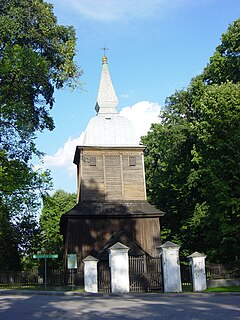
Polanka Wielka is a village in Oświęcim County, Lesser Poland Voivodeship, in southern Poland. It is the seat of the gmina called Gmina Polanka Wielka. It lies approximately 10 kilometres (6 mi) south-east of Oświęcim and 46 km (29 mi) west of the regional capital Kraków.
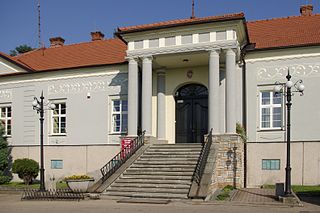
Bestwina is a village in Bielsko County, Silesian Voivodeship, in southern Poland. It is the seat of the gmina called Gmina Bestwina. It lies approximately 8 kilometres (5 mi) north of Bielsko-Biała and 40 km (25 mi) south of the regional capital Katowice.

Pisarzowice is a village in the administrative district of Gmina Wilamowice, within Bielsko County, Silesian Voivodeship, in southern Poland. It lies approximately 4 kilometres (2 mi) south of Wilamowice, 8 km (5 mi) north-east of Bielsko-Biała, and 42 km (26 mi) south of the regional capital Katowice. The village has a population of 4,673.
